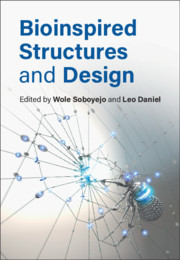Book contents
- Bioinspired Structures and Design
- Bioinspired Structures and Design
- Copyright page
- Contents
- Contributors
- Preface
- Part I Materials
- Part II Structures
- Part III Natural Phenomena
- 10 Aquatic Animals Operating at High Reynolds Numbers
- 11 Flying of Insects
- 12 Designing Nature-Inspired Liquid-Repellent Surfaces
- 13 Biomimetic and Soft Robotics
- 14 Bioinspired Building Envelopes
- Index
- References
13 - Biomimetic and Soft Robotics
Materials, Mechanics, and Mechanisms
from Part III - Natural Phenomena
Published online by Cambridge University Press: 28 August 2020
- Bioinspired Structures and Design
- Bioinspired Structures and Design
- Copyright page
- Contents
- Contributors
- Preface
- Part I Materials
- Part II Structures
- Part III Natural Phenomena
- 10 Aquatic Animals Operating at High Reynolds Numbers
- 11 Flying of Insects
- 12 Designing Nature-Inspired Liquid-Repellent Surfaces
- 13 Biomimetic and Soft Robotics
- 14 Bioinspired Building Envelopes
- Index
- References
Summary
Since the advent of the first programmable robotic arm in the early 1960s by George C. Devol, the robotics industry has seen fast growth, and nowadays robotic arms are ubiquitous in automobile assembly lines. In addition to those fixed to the ground as in the robotic arm case, autonomous mobile robots have also been designed and manufactured, and have found ample applications in many areas such as space and deep-sea exploration, thanks to synergistic progress in control, actuation, and information technology, among others. These robots are featured with high accuracy for force and position control. They are ideal for repetitive tasks that quickly bore humans. They make many fewer mistakes. Their bodies are made of hard materials, such as metals and hard plastics, while their control and actuation units use metal or semiconductors such as silicon for electronics.
- Type
- Chapter
- Information
- Bioinspired Structures and Design , pp. 320 - 342Publisher: Cambridge University PressPrint publication year: 2020



